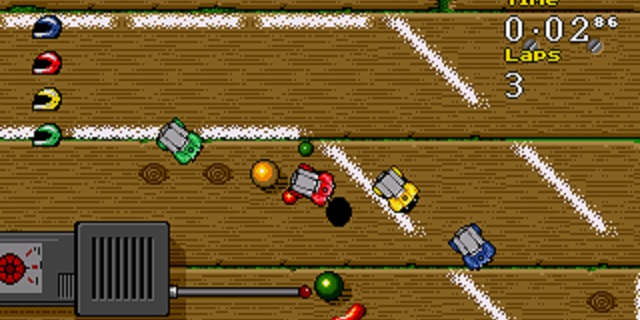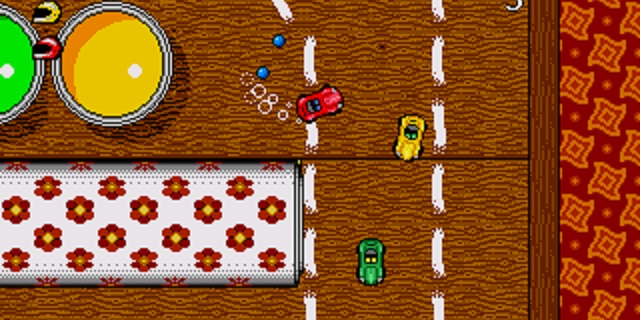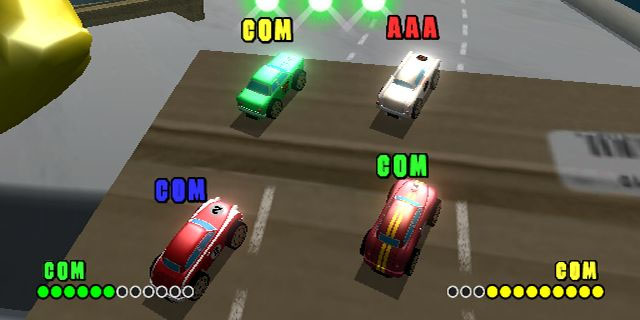
The vehicles in Micro Machines have this wildly-exaggerated movement. They feel as if they were actually small cars, with little weight and a powerful engine. They accelerate in seconds to ludicrous speeds, raising their kinetic energy to levels your small traction can’t keep under control. Cars bounce around corners, and go flying when hit just to criss-cross the road a second later. It’s fast and chaotic, yet (with practice) perfectly controllable.
In most racing games, taking a difficult turn means slowing down or taking it wide, but Micro Machines can change their inertia so rapidly that overshooting corners and quickly changing direction is often faster than turning. This allows the player to squeeze his car in the small spaces left by his competitors.
I say often, because not all vehicles have the same physics. Sports cars are rear-powered and drift when turning, but trying to drift with a Dragster spells disaster for anyone crazy enough to try it. Powerboats turn faster than they should, and reaching maximum speed with those big and clunky Electrics requires turning at the last minute to milk each straight section of the road for all it’s worth.

This is not, and I feel this is quite important, an attempt to disguise shallow game mechanics with variety. There’s this “toys move on their own” idea under the surface that ties every single vehicle, more like ramifications of the concept than different ideas being put together.
This is noticeable while crashing, because there’s practically no penalty to it. The player may drop off the table or sink in the bathtub, but there aren’t any chest-high walls that define the layout. Most hazards make makes you bounce instead of being actually damaging, and grinding against rival cars doesn’t mean anything. It can’t be stressed enough that these are small cars. They cannot crash or push with force; they are toys no bigger than a pencil sharpener.
There’s another interesting aspect of Micro Machines: strategic memorization. Turns are nasty and quick, and knowing how to approach each of them is incredibly important. There’s a certain strategic component to how you drive around the circuit or when you slow down that only appears after repeated plays against the obsessive AI. It reminds me of Capcom games; there’s no strict pattern to follow, but each enemy has to be met with a plan in order to reliably succeed.

Yet this doesn’t make for an unapproachable game. Micro Machines is in that sought-after “easy to learn, hard to master” category, and the bite-sized multiplayer aspect covering as many as 16 players in a variety of leagues and tournaments makes for a great party game for those that want laughs with a bit of nuance. They are fun games, and the additional controller ports shouldn’t go unused.
Want to give them a try? Start with either Micro Machines Turbo Tournament 2, the no-fat 16-bit classic, or the modernized Micro Machines V4, which adds weapons and 3D graphics as well as a lowered level of difficulty but keeps the fun taste. Of course, us lucky Europeans have access to Micro Machines Turbo Tournament ’96, an upgrade of the original formula that I play over and over.



















